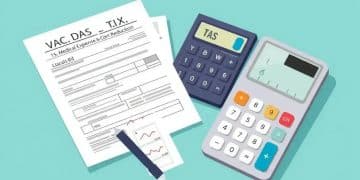Federal Reserve maintains restrictive monetary policy amid inflation

The Federal Reserve maintains restrictive monetary policy by adjusting interest rates to control inflation, directly impacting consumer spending, borrowing costs, and overall economic growth.
Federal Reserve maintains restrictive monetary policy as inflation concerns take center stage. Have you noticed the increasing cost of living? This policy affects not only the economy but also your wallet.
Understanding the Federal Reserve’s Role
The Federal Reserve, often called the Fed, plays a vital role in our economy. Understanding how it operates helps us see its impact on our daily lives.
What is the Federal Reserve?
The Federal Reserve is the central bank of the United States. Established in 1913, its primary purpose is to maintain financial stability. It manages the country’s money supply and influences interest rates. This helps control inflation and support economic growth.
Key Functions of the Federal Reserve
The Fed has several important functions:
- Monetary Policy: The Fed uses monetary policy to control inflation and stabilize the economy.
- Bank Supervision: It monitors and regulates banks to ensure safety and soundness.
- Financial Services: Provides financial services to the government and financial institutions.
- Consumer Protection: The Fed also works to protect consumers in financial transactions.
By managing the money supply, the Fed can influence interest rates. Lowering rates usually encourages borrowing and spending. This can boost the economy, but it can also lead to inflation if done excessively.
On the other hand, raising interest rates can help cool down an overheating economy. This is often necessary when inflation is high. The Fed carefully considers various economic indicators before making such decisions.
Understanding the Chain Reaction
The decisions made by the Federal Reserve have far-reaching effects. When the Fed changes interest rates, it impacts everyone—businesses, consumers, and even global markets. For instance, if rates go up, borrowing costs rise, leading to less spending by consumers. In contrast, if rates are dropped, people might borrow more to buy homes or cars, stimulating the economy.
The Fed’s actions also affect employment rates. When borrowing is easier, businesses may hire more workers to meet increased demand. However, high interest rates can slow down hiring as companies become more cautious about their spending.
Impact of Restrictive Policies on the Economy

The impact of restrictive policies on the economy is significant and far-reaching. These policies, often enacted by the Federal Reserve, aim to control inflation and stabilize financial markets.
Effects on Growth
When the Fed implements restrictive measures, such as raising interest rates, economic growth can slow down. Higher interest rates can deter borrowing. Businesses might hesitate to invest in new projects, which can limit job creation.
- Reduced Consumer Spending: Higher rates mean higher borrowing costs, leading consumers to spend less.
- Business Caution: Companies may delay expansion plans to avoid potential losses.
- Market Reactions: Stock and bond markets tend to react negatively as investors reassess risk.
The restrained growth can result in lower overall demand for goods and services. This could lead to fewer job opportunities and stagnant wages. While the goal is to combat inflation, the trade-off can affect everyday lives.
Inflation Control Measures
Restrictive policies are primarily aimed at controlling inflation. By making loans more expensive, the Fed can curb excessive spending. Yet, this approach can lead to unintended consequences. For example, while inflation may decrease, the economy might also suffer from reduced liquidity.
Individuals may find it more challenging to obtain mortgages or loans for significant purchases, impacting their financial decisions. Furthermore, small businesses, which depend on affordable credit, may face hardships. The ripple effect through the economy can impede growth and innovation.
How Higher Interest Rates Affect Consumers
Higher interest rates have a direct and noticeable effect on consumers. When the Federal Reserve raises rates, borrowing costs increase. This change in rates can reshape consumer behavior in several ways.
Impact on Loans and Mortgages
When interest rates rise, the cost of loans also goes up. Many people rely on loans to buy homes or cars. As rates climb, monthly payments can become unaffordable for some.
- Mortgage Payments: Higher rates lead to increased mortgage payments, which can push potential buyers out of the market.
- Car Loans: Consumers may delay purchasing a new car if loan rates are high, affecting the auto industry.
- Credit Cards: Balances on existing credit cards become more expensive as rates increase, leading to higher interest payments.
With higher borrowing costs, many consumers reevaluate their spending plans. They may choose to save more, which can slow down the economy as spending decreases.
Saving vs. Spending
As borrowing becomes more expensive, some consumers may turn to savings. Higher interest rates can encourage saving because people can earn more interest on their savings accounts. However, the trade-off is clear: while saving increases, spending decreases.
The kitchen appliance market, for example, might see fewer purchases when consumers prioritize saving over immediate buying. Families may hold off on vacations or big purchases, opting instead to build their savings.
Such shifts in behavior can have a broader impact on businesses. Retailers might struggle as consumers cut back on non-essential spending. As a result, businesses could face lower revenues, potentially leading to fewer jobs or salary reductions.
Future Predictions for Monetary Policy

The future of monetary policy is a topic of keen interest, especially as the Federal Reserve navigates complex economic challenges. Predictions about how policies will evolve can help consumers and investors make informed decisions.
Potential Rate Changes
Analysts speculate that the Fed may continue to adjust interest rates based on economic indicators. If inflation remains high, further rate hikes could be necessary. Conversely, if the economy shows signs of slowing, rate reductions might be on the horizon.
- Inflation Trends: Monitoring inflation rates will be critical in determining future rate adjustments.
- Economic Growth: If growth slows significantly, the Fed might consider lowering rates to stimulate activity.
- Global Markets: International economic conditions can also influence the Fed’s decisions.
These predictions create a ripple effect across various sectors of the economy. Businesses may adjust their practices, consumers might alter their spending habits, and investors could reevaluate their portfolios.
Impact on Consumers and Businesses
The potential changes to monetary policy will affect consumers and businesses alike. Higher interest rates can curb spending, leading to slower economic growth. On the other hand, lower rates can encourage borrowing and spending, which can boost the economy.
For consumers, the future may hold a mix of challenges and opportunities. With fluctuating rates, budgeting for big purchases like homes or cars becomes more complicated.
In summary, the Federal Reserve’s monetary policy plays a crucial role in shaping the economy. Understanding how interest rates impact consumers and businesses is essential, as these changes can influence spending, borrowing, and saving patterns. As we look to the future, monitoring trends in inflation and economic growth will help us anticipate potential shifts in policy. The decisions made by the Fed will continue to affect everyday lives, making it important for consumers and businesses to stay informed and prepared for changes ahead.
FAQ – Frequently Asked Questions about Monetary Policy
How do higher interest rates affect consumer spending?
Higher interest rates increase borrowing costs, leading consumers to spend less on loans and mortgages.
What is the role of the Federal Reserve in the economy?
The Federal Reserve manages monetary policy to control inflation and support economic stability.
Why is monitoring inflation important?
Monitoring inflation helps predict future interest rate changes, which can impact consumers and businesses.
How can consumers prepare for changes in interest rates?
Consumers can stay informed about economic trends and adjust their budgets to manage potential rate increases.






